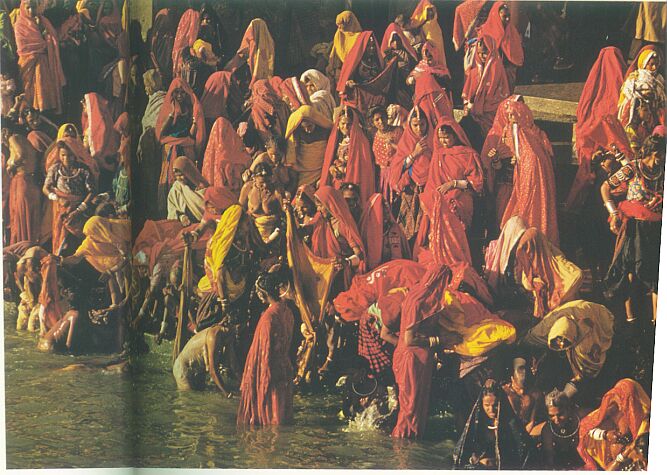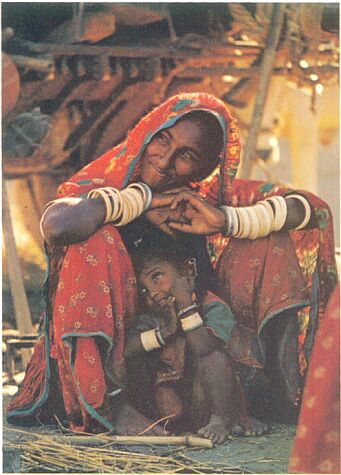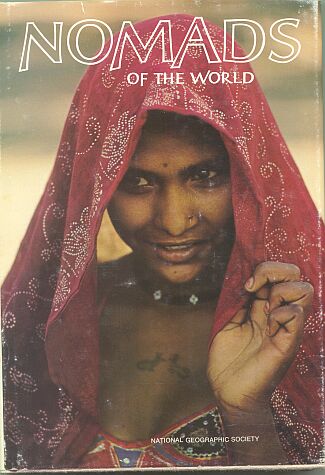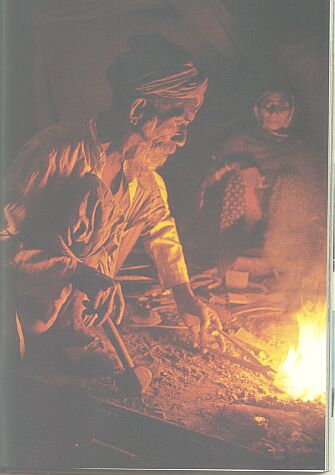Posted by R. John Howe on 02-23-2004 05:48 PM:
Migrant Blacksmiths in Sarees
Dear folks –
A few months ago Michael Wendorf reminded me in a
reference to it, that I had a book entitled “Nomads of the World,” a National
Geographic publication. I looked through it in my review of my books for
possible instances of sarees, without really expecting to find any.
But
an article on the Gaduliya Lohars of India surprised me. The Lohars are cart
blacksmiths who migrate somewhat in their work. They travel in carts pulled by
bullocks.
The Lohar women wear a species of saree called “odhani,”
described as being composed of “yards and yards" of fabric. Here is a photo of a
group of Lohar women ritually bathing as part of their religious
practice.

You can see that they are wearing saree-like
garments.
Here are a couple of closer pictures of Lohar women and their
dress. First, a woman with a child.

And here is the cover photo
on this book, also of a Lohar woman.

The odhanis are often, the
text says, decorated with peacock designs.
So these migratory women do
seem to wear saree-like garments, but the real surprise was in the accompanying
text. Listen to this passage:
“…Even if I had not known the site, I could
have gone straight to it from the bus stop. All I had to do was walk toward the
slow, rhythmic pounding of their sledgehammer. Thud…thud…thud…
“Despite
having seen these artisan nomads at work many times during the 11 years I have
studied them, I still find the scene rather startling, mostly because the person
swinging the long-handled hammer, or “ghan,” is usually a woman.
“In her
long skirt of brightly printed cotton, her red and green “kanchali,” or
brassiere, and her light “odhani” yards of gaudy cloth draped loosely about her,
she stands barefoot before the little anvil, the “eran.” Over her shoulder she
raises the great hammer and brings it smashing down. Again and again she
strikes. Thud! Thud! She hits the ten-pound hammerhead against a scrap of
fire-hot iron her husband holds with tongs on the anvil. Her 46 ivory – or
plastic – bracelets, irremovable symbols of marriage, jangle and click with each
blow.
“Slender, barely five feet tall, and often either pregnant or still
suckling a child, she may work 10 to 14 hours a day at the anvil in addition to
grinding grain to make bread, carrying water, cooking and looking after the
children.

“But until her sons grow strong enough to share her job, she
must swing the hammer to help her husband earn a meager living. During a few
months in early spring and fall, they may work from dawn into night beating iron
bars into plowshares, sickles, hoes, wheel rims, and bullock shoes for busy
farmers. On such a day, they can net as much as 10 rupees, less than $1.50 or
about 15 cents a plowshare. Among the Lohars a lazy person is considered as
immoral as one who steals and only a little less sinful than one who kills a
sacred cow or cobra.”
A truly unexpected find: nomadic female blacksmiths
in sarees.
Regards,
R. John Howe
Posted by Mishra Jaina on 02-23-2004 08:30 PM:
Hi,
Isn't the uniform colour just marvellous ?
The people of
the desert state of Rajasthan which is to the West -have a preference for the
hot colours - oranges and reds.
They have gorgoeus tie-n-dye works called
'bandhini' which come in saree forms as well as Odhinis - in cottons and silk.
They share a border with the state of Gujarat and mirror work on
textiles is also very common - called "abhalaa". Several styles of abhalaa work
are seen and possibly have originated in different parts of these states.
The state of Rajasthan is a treasure trove of art - their architecture
e.g. Umaid Bhavan Palace - their old silver jewellery - their textiles all are
breathtaking. The bone / ivory armbands that get progressivley wider are worn
for life !
Even the men have a very quaint very cute dress
......
Will send some pictures to Steve to post.
Jaina Mishra
Posted by Danny Mehra on 02-23-2004 09:28 PM:
Lohars and Lurs?
Thanks, Jaina and John. This is indeed a terrific salon.
Your thread
about Lohars is intriguing.
As a quick aside, these "Lohars" are also
known as one of the nomadic Indian gypsy tribes. If I remember correctly, some
of these tribes are supposed to have migrated all the way up through Central and
Eastern Europe and have become assimilated with the gypsy tribes that have
settled in those parts of the world today.
As another quick aside, if you
recall the Luri salon by Pat Weiler, there was a thread in there where we were
debating the connection between Luris and Lohars. Loha means iron. Lohars are
ironsmiths. And Lahore, the Pakistani city, may also have some remote connection
thereto. As may also my late father-in-law's family - Laroia - who originally
came from Lahore.
Small world! Makes one want to see more of
it!
Thanks
Danny
Posted by R. John Howe on 02-24-2004 07:03 AM:
Jaina -
In your post above you said in part, referring to the
Lohars:
"...They have gorgeous tie-n-dye works called 'bandhini' which
come in saree forms as well as Odhinis - in cottons and
silk."
Me:
There seems to be a distinction in your sentence here
between "saree forms" and "Odhinis." Perhaps this is part of what you can help
us understand. Are "Odhinis" not a species of "saree?"
Regards,
R.
John Howe
Posted by Mishra Jaina on 02-24-2004 08:33 AM:
Hi,
No - Odhinis are, in my understanding shorter versions of the
saree. They may worn as a 'half - sari' which means that the skirt can be seen a
lot. It gets tucked into the front near the navel and goes to the back and gets
diagnolly crossed over the shoulder almost immediately. The skirts used with
half saris are necessarily prettier and well decorated.
The saree on the
other hand goes around at the waist level for a complete round, and pleats are
created by folding the fabric over before tucking in, and only after the
complete circling does it go over the shoulder diagnally. Since the skirt is
fully covered in this case, it usually is much like a plain petticoat.
Since odhinis are structurally the same as 'dupattas' in the sense that
the length is the same, they can be interchanged. A dupatta is worn over the
shoulders and is free at both ends.
Jaina Mishra



